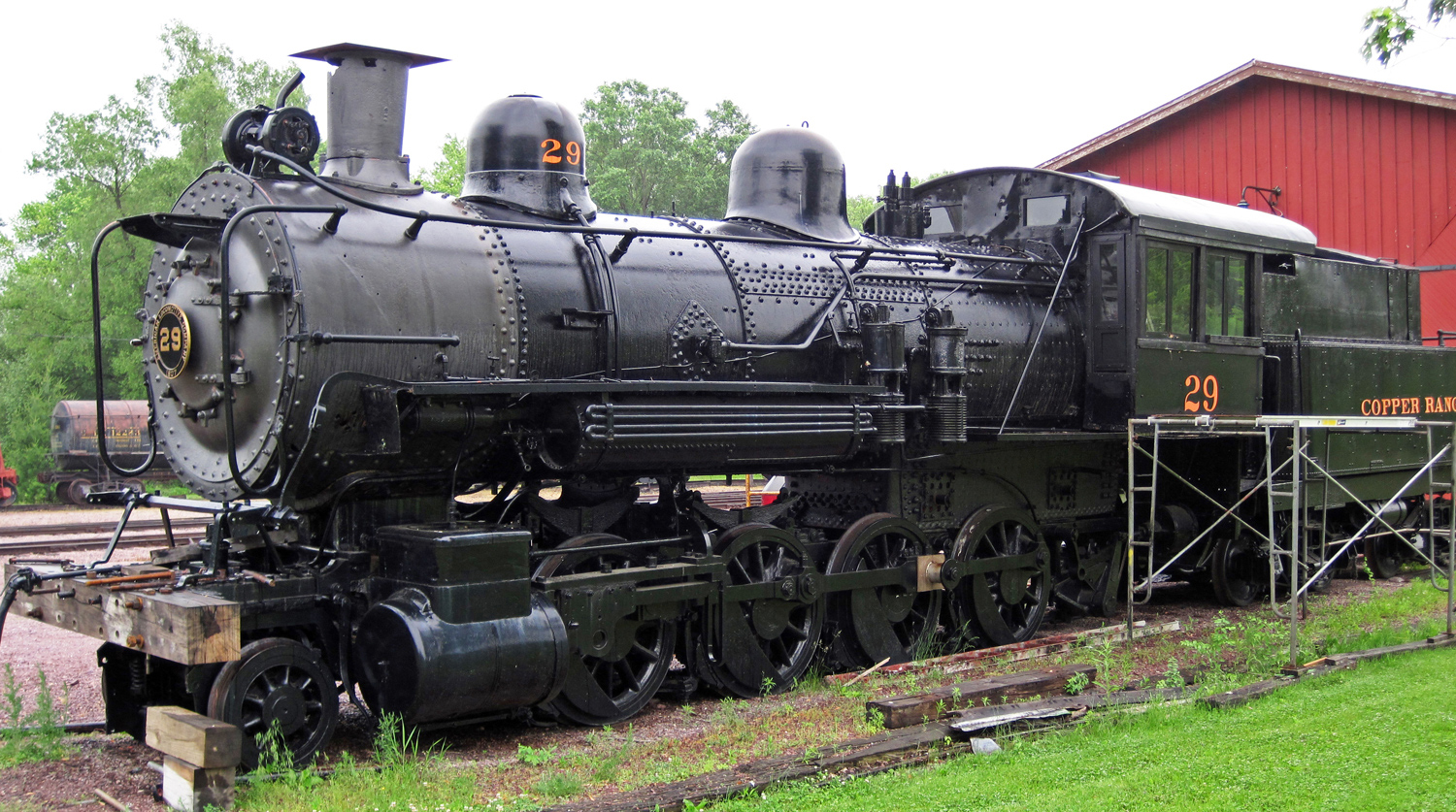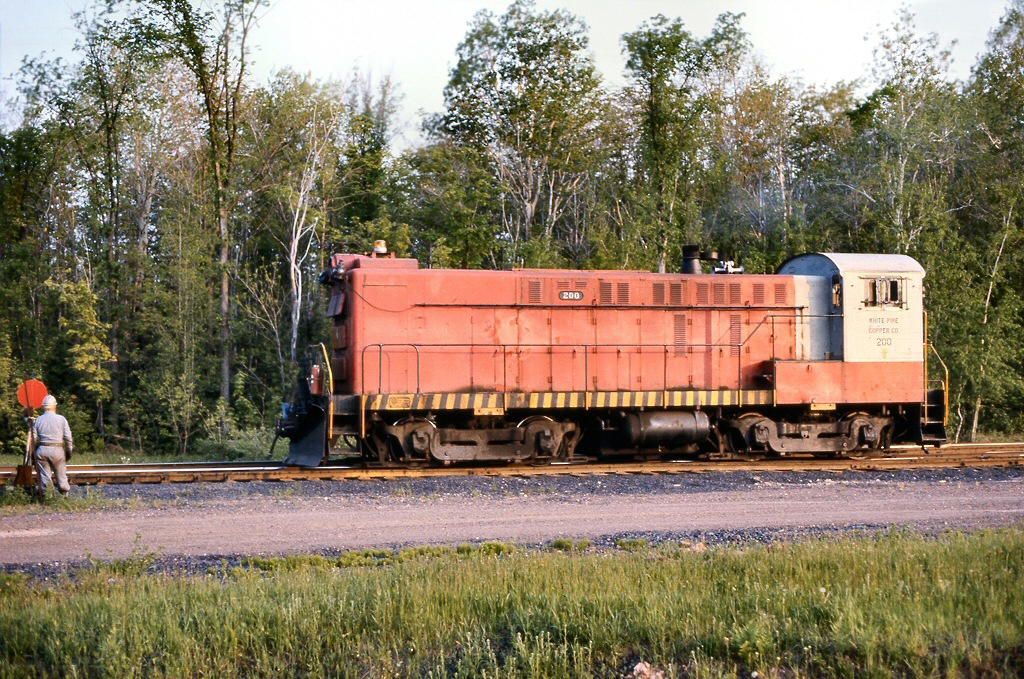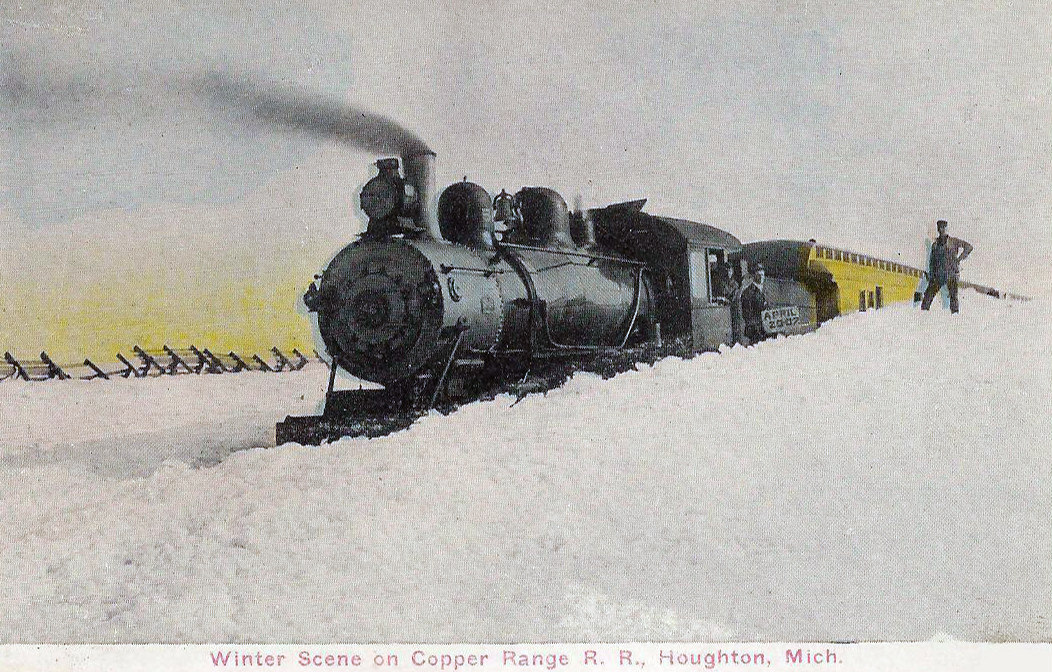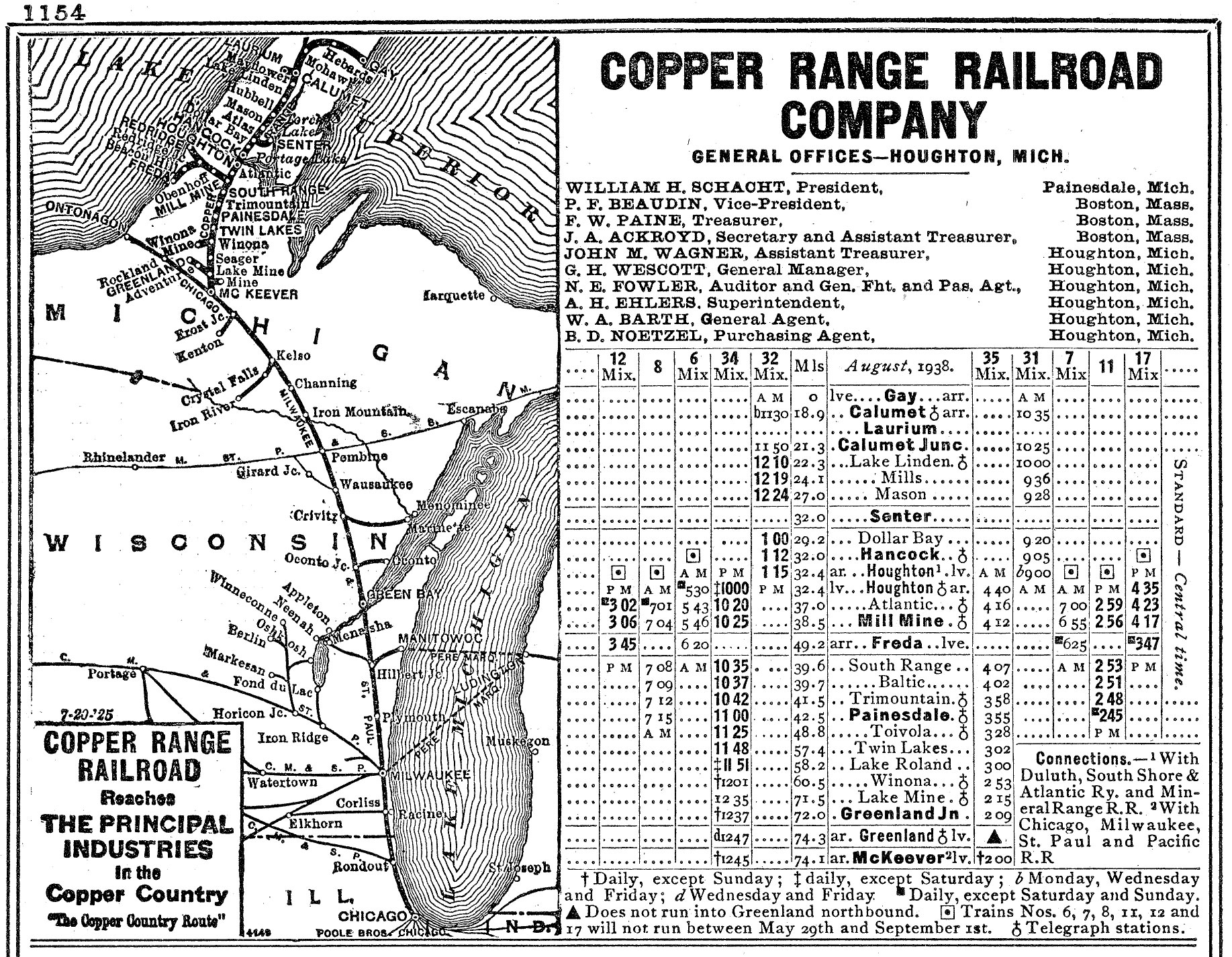Copper Range Railroad: Serving The Keweenaw Peninsula
Last revised: September 3, 2024
By: Adam Burns
The Copper Range Railroad (reporting marks, COPR) was a classic shortline serving the Keweenaw
Peninsula of Michigan.
It was owned and operated by the Copper Range Company to serve several mines in the region with a connection to the Chicago, Milwaukee, St. Paul & Pacific (the Milwaukee Road) at McKeever as well as the Soo farther north.
At its peak the system was nearly 75 miles in length with several spurs branching from its main line between McKeever to as far north as Gay.
The railroad was built with a twofold purpose. Primarily, to effectively transfer copper from the mines to the smelters, and subsequently, transport the refined metal to market. Additionally, it was crucial in bringing in laborers and supplies to the remote mining towns of the Keweenaw Peninsula.
The earliest history of railroads serving the region dated to the 1870s via a narrow-gauge line although the Copper Range itself was not officially created for another 15 years following.
After World War II the system slowly declined and cutback as mines played out and closed.
By the early 1970s virtually all major traffic had disappeared and the railroad was officially abandoned with tracks scrapped soon afterward. Today, sections of the original line are now a rail/trail.
Formation
The history of the Copper Range Railroad was chartered in March of 1899 to serve its parent's extensive mining network around the Portage Lake region of the Keweenaw Peninsula.
Since 1873 a line had already been operating between Hancock and Calumet, the narrow-gauge, 14-mile long Mineral Range Railroad. Construction of the new route began that spring of 1899 and by December it was opened between Houghton and Winona, 28.9 miles.
The railroad also by then had established its primary yard and offices in Houghton, which also included a roundhouse and all major maintenance facilities.
This town sat at about the half-way point once the system was completed and also connected with the Mineral Range, a setup that lasted for many years as it later became part of the Duluth, South Shore & Atlantic Railway (DSS&A) which itself was purchased by the Soo Line.
At A Glance
McKeever (Milwaukee Road) Houghton (Soo Line and Mineral Range Railroad) | |
By around 1913 the Copper Range had been completed in terms of both its 74.1-mile main line between McKeever and Gay as well as its many branches.
Mine Branches
In all, the railroad had about six branches of some size that included:
- Calumet to Mayflower.
- Dollar Bay to Senter.
- Winona to the Winona Mine.
- Lake Mine to Greenland.
- A short spur to Mine (just north of McKeever).
- The major branch that split from Mill Mine and reached Redridge to the west.
- Finally, a short southward spur to Freda.
These secondary routes connected to a wide array of copper mines.
However, the Copper Range also served coal mines around South Range, lumber mills (notable was the Boniface-Gorman Lumber Company at the northern end of the system in Gay), stamp mills, and the Michigan Smelting Company near Houghton.
It's somewhat amazing the amount of mines the railroad served given that the peninsula is only 70+ miles in length.
 Copper Range Railroad 2-8-0 #29 (C-2) preserved at the Mid-Continent Railway Museum in North Freedom, Wisconsin. The Consolidation was built by Alco's Schenectady Works in 1907. James St. John photo.
Copper Range Railroad 2-8-0 #29 (C-2) preserved at the Mid-Continent Railway Museum in North Freedom, Wisconsin. The Consolidation was built by Alco's Schenectady Works in 1907. James St. John photo.Motive Power
Typical power for the Copper Range Railroad during the steam era including the 2-8-0 Consolidation, its workhorse.
Most of these locomotives were built by the American Locomotive Company's Schenectady, New York facility that ranged in size from 96 to 100 tons; other wheel arrangements the company owned included 2-6-0 Moguls, 4-6-0 Ten Wheelers, and 4-4-0 Americans.
After 1910 the Copper Range reached trackage rights agreements with the Milwaukee Road to extend its passenger services east to Channing and west to Ontonagon along the banks of Lake Superior.
In general, the railroad did not invest heavily in passenger operations due to the lightly populated area although it did offer daily service for many years, especially early on (at one time it even hosted an observation car on its trains).
Later, as demand decline the only way to catch a train was via a mixed freight. This practice was finally cancelled after 1950.
Bankruptcy
As early as the summer of 1927 mines along the Copper Range Railroad began to close, the first of which was the Seneca Mine.
The company's only bankruptcy followed on March 26, 1935 due to the ongoing depression although it was able to exit receivership a few years later on July 1, 1938.
At this time it had just nine steam locomotives still in operation, nearly all of which were its 2-8-0s. Diesels began arriving in April of 1947, two Baldwin-built DS-4-4-1000 switchers #100-101.
Interestingly, Copper Range management insisted that the new locomotives be "painted in a scheme identical to that illustrated in the Baldwin's catalog."
Thus, they sported a red on the hood which trailed away into a light grey with yellow trim here and there. A few years later during July of 1951 the company picked up one more, a Baldwin S-12, #200.
System Map and Timetable (1925)
This essentially completed its diesel roster, as steam had been completely retired by 1947 with the purchase of the two DS-4-4-1000s.
Final Years
The decline and eventual abandonment of the Copper Range Railroad was predicated on multiple factors. One significant factor was the rise of automotive and trucking industries.
Road transport not only presented a more flexible alternative but also required less maintenance. Additionally, as copper mining began to wane in the Keweenaw Peninsula, the railroad experienced a steady decrease in traffic and revenue.
 White Pine Copper Mine S-12 #200, ex-Copper Range Railroad #200 built by Baldwin in 1951, enters a switch at White Pine, Michigan in June of 1976. Rob Kitchen photo.
White Pine Copper Mine S-12 #200, ex-Copper Range Railroad #200 built by Baldwin in 1951, enters a switch at White Pine, Michigan in June of 1976. Rob Kitchen photo.Decline for the Copper Range Railroad continued through the 1950s and 1960s as more mines closed. By 1969 only 52.8 miles of the main line remained between Lake Linden (22.3 miles south of the original northern terminus at Gay) and McKeever with the only branch line still in use served the Winona Mine.
On August 24, 1972 permission was granted from the Interstate Commerce Commission (ICC) for total abandonment and the last train ran that year on November 3.
By the spring of 1974 the entire railroad had been pulled up and scrapped. Ironically, today, one could hardly tell trains ever ran through the Keweenaw Peninsula as the Soo Line and Milwaukee Road branches were also abandoned long ago.
Legacy
While the railroad ceased operations in the late 20th century, it certainly left behind an indelible mark. Its influence in the region is seen through the vestiges of mining towns and industries it once served. The towns of Houghton and Hancock, for instance, owe much of their development to the railroad.
Interestingly, the story of the Copper Range Railroad does not end with its abandonment. Post-cessation, portions of the railroad's route were repurposed into public recreational trails.
The Copper Country Trail National Byway, for example, which winds through Michigan's Copper Country, offers a scenic outdoor experience for residents and visitors.
In conclusion, the Copper Range Railroad, much like its sister, the Mineral Range Railroad, remains a symbol of America's industrial past. Both played pivotal roles in shaping not only the Keweenaw Peninsula but also the wider industrial landscape of Northern Michigan.
The remnants of this once-mighty railroad stand as silent reminders of a bygone era, offering insights into a time when rails carried the hopes and dreams of many, much like the copper they hauled.
Recent Articles
-
Wisconsin's Dinner Train Rides In North Freedom!
Jan 20, 26 01:55 PM
Featured here is a practical guide to Mid-Continent’s dining train concept—what the experience is like, the kinds of menus the museum has offered, and what to expect when you book. -
New York's Dinner Train Rides In The Adirondacks!
Jan 20, 26 12:41 PM
Operating over a restored segment of the former New York Central’s Adirondack Division, the Adirondack Railroad has steadily rebuilt both track and public interest in passenger rail across the region. -
Pennsylvania "Dinner Train" Rides In Boyertown!
Jan 20, 26 12:04 PM
With beautifully restored vintage equipment, carefully curated menus, and theatrical storytelling woven into each trip, the Colebrookdale Railroad offers far more than a simple meal on rails. -
New York ~ Murder Mystery ~ Dinner Train Rides
Jan 20, 26 12:03 PM
New York State, renowned for its vibrant cities and verdant countryside, offers a plethora of activities for locals and tourists alike, including murder mystery train rides! -
Pennsylvania ~ Murder Mystery ~ Dinner Train Rides
Jan 20, 26 11:48 AM
Pennsylvania, steeped in history and industrial heritage, offers a prime setting for a unique blend of dining and drama: the murder mystery dinner train ride. -
Florida Valentine's Train Rides
Jan 20, 26 11:46 AM
For couples looking for something different this Valentine’s Day, the museum’s signature romantic event is back: the Valentine Limited, returning February 14, 2026—a festive evening built around a tra… -
Connecticut Valentine's Train Rides
Jan 20, 26 11:43 AM
Operated by the Valley Railroad Company, the attraction has been welcoming visitors to the lower Connecticut River Valley for decades, preserving the feel of classic rail travel while packaging it int… -
Texas Dinner Train Rides At The TSR!
Jan 19, 26 12:30 PM
Today, TSR markets itself as a round-trip, four-hour, 25-mile journey between Palestine and Rusk—an easy day trip (or date-night centerpiece) with just the right amount of history baked in. -
Iowa's Dinner Train Rides In Boone!
Jan 19, 26 12:28 PM
If you’ve ever wished you could pair a leisurely rail journey with a proper sit-down meal—white tablecloths, big windows, and countryside rolling by—the Boone & Scenic Valley Railroad & Museum… -
Ohio Dinner Train Rides At The CVSR!
Jan 19, 26 12:27 PM
While the railroad is well known for daytime sightseeing and seasonal events, one of its most memorable offerings is its evening dining program—an experience that blends vintage passenger-car ambience… -
Missouri's Dinner Train Rides In Branson!
Jan 19, 26 12:21 PM
Nestled in the heart of the Ozarks, the Branson Scenic Railway offers one of the most distinctive rail experiences in the Midwest—pairing classic passenger railroading with sweeping mountain scenery a… -
Virginia Valentine's Train Rides
Jan 19, 26 12:15 PM
If you’ve ever wanted to slow life down to the rhythm of jointed rail—coffee in hand, wide windows framing pastureland, forests, and mountain ridges—the Virginia Scenic Railway (VSR) is built for exac… -
Maryland Valentine's Train Rides
Jan 19, 26 12:12 PM
The Western Maryland Scenic Railroad (WMSR) delivers one of the East’s most “complete” heritage-rail experiences: and also offer their popular dinner train during the Valentine's Day weekend. -
Indiana's Dinner Train Rides In Jasper!
Jan 18, 26 01:54 PM
In the rolling hills of southern Indiana, the Spirit of Jasper offers one of those rare attractions that feels equal parts throwback and treat-yourself night out: a classic excursion train paired with… -
New Mexico's Dinner Train Rides
Jan 18, 26 01:37 PM
If your heart is set on clinking glasses while the desert glows at sunset, you can absolutely do that here—just know which operator offers what, and plan accordingly. -
New Hampshire ~ Murder Mystery ~ Dinner Train Rides
Jan 18, 26 01:10 PM
The state's murder mystery trains stand out as a captivating blend of theatrical drama, exquisite dining, and scenic rail travel. -
New York Valentine's Train Rides
Jan 18, 26 12:32 PM
At its best, the Adirondack Railroad delivers exactly what railfans and casual riders alike hope for: vintage coaches, classic depots, rivers and forests right outside the window. -
Washington Valentine's Train Rides
Jan 18, 26 10:50 AM
Whether you’re a dedicated railfan chasing preserved equipment or a couple looking for a memorable night out, CCR&M offers a “small railroad, big experience” vibe—one that shines brightest on its spec… -
Colorado Valentine's Train Rides
Jan 18, 26 10:49 AM
The Royal Gorge Route Railroad is the kind of trip that feels tailor-made for railfans and casual travelers alike, including during Valentine's weekend. -
Georgia Valentine's Train Rides
Jan 18, 26 10:42 AM
f you’ve ridden the SAM Shortline, it’s easy to think of it purely as a modern-day pleasure train—vintage cars, wide South Georgia skies, and a relaxed pace that feels worlds away from interstates and… -
New Jersey ~ Murder Mystery ~ Dinner Train Rides
Jan 17, 26 01:16 PM
There are currently no murder mystery dinner trains available in New Jersey although until 2023 the Cape May Seashore Lines offered this event. Perhaps they will again soon! -
West Virginia Dinner Train Rides In Elkins!
Jan 17, 26 01:08 PM
The D&GV offers the kind of rail experience that feels purpose-built for railfans and casual travelers. -
Virginia Dinner Train Rides In Staunton!
Jan 17, 26 11:55 AM
If you’ve ever wished you could pair a classic scenic train ride with a genuinely satisfying meal—served at your table while the countryside rolls by—the Virginia Scenic Railway was built for you. -
Florida Easter Train Rides
Jan 17, 26 10:23 AM
The cold weather rarely invades Florida and the state nearly always warm and balmy early spring temperatures. Learn more about where you can find Easter-themed train rides across the Sunshine State. -
Ohio Easter Train Rides
Jan 17, 26 10:13 AM
Ohio is home to several museums and excursion trains preserving the state's rich railroading heritage. A few of these locations host Easter-themed train rides each spring. -
Massachusetts Valentine's Train Rides
Jan 17, 26 09:58 AM
The Cape Cod Central Railroad (CCCR) blends classic New England scenery with heritage equipment, narrated sightseeing, and some of the region’s best-known “rails-and-meals” experiences. -
California Valentine's Train Rides
Jan 17, 26 09:53 AM
Operating out of West Sacramento, this excursion railroad has built a calendar that blends scenery with experiences—wine pours, themed parties, dinner-and-entertainment outings, and seasonal specials… -
South Carolina Dinner Train Rides
Jan 16, 26 11:13 PM
There is only location in the Palmetto State offering a true dinner train experience can be found at the South Carolina Railroad Museum. Learn more here. -
Rhode Island Dinner Train Rides
Jan 16, 26 11:01 PM
Despite its small size, Rhode Island is home to one popular dinner train experience where guests can enjoy the breathtaking views of Aquidneck Island. -
Pennsylvania's Thomas The Train Rides
Jan 16, 26 04:13 PM
"A Day Out With Thomas” train rides offer a unique opportunity for children and their families to engage in a magical and memorable experience, setting the stage for a full day of fun and adventure. -
Illinois's Thomas The Train Rides
Jan 16, 26 02:23 PM
In Illinois, the "A Day Out With Thomas" event offers a unique chance for families to immerse themselves in the enchanting world of Thomas and friends, creating memories that last a lifetime. -
New Jersey's Thomas The Train Rides
Jan 16, 26 02:11 PM
Here's a comprehensive guide to what you can expect at Day Out With Thomas events in New Jersey. -
Texas ~ Murder Mystery ~ Dinner Train Rides
Jan 16, 26 01:54 PM
Here’s a comprehensive look into the world of murder mystery dinner trains in Texas. -
Connecticut ~ Murder Mystery ~ Dinner Train Rides
Jan 16, 26 01:26 PM
All aboard the intrigue express! One location in Connecticut typically offers a unique and thrilling experience for both locals and visitors alike, murder mystery trains. -
New Hampshire Dinner Train Rides In N. Conway!
Jan 16, 26 10:47 AM
Tucked into the heart of New Hampshire’s Mount Washington Valley, the Conway Scenic Railroad is one of New England’s most beloved heritage railways -
Oregon Dinner Train Rides Near Mt. Hood!
Jan 16, 26 10:44 AM
The Mt. Hood Railroad is the moving part of that postcard—a century-old short line that began as a working railroad. -
Maryland's - Wine Tasting - Train Rides
Jan 15, 26 02:59 PM
This article delves into the enchanting world of wine tasting train experiences in Maryland, providing a detailed exploration of their offerings, history, and allure. -
Colorado's - Wine Tasting - Train Rides
Jan 15, 26 02:46 PM
To truly savor these local flavors while soaking in the scenic beauty of Colorado, the concept of wine tasting trains has emerged, offering both locals and tourists a luxurious and immersive indulgenc… -
Iowa ~ Wine Tasting ~ Train Rides
Jan 15, 26 02:36 PM
The state not only boasts a burgeoning wine industry but also offers unique experiences such as wine by rail aboard the Boone & Scenic Valley Railroad. -
Georgia's Wine Train Rides In Cordele!
Jan 15, 26 02:26 PM
While the railroad offers a range of themed trips throughout the year, one of its most crowd-pleasing special events is the Wine & Cheese Train—a short, scenic round trip designed to feel like a t… -
Indiana ~ Murder Mystery ~ Dinner Train Rides
Jan 15, 26 02:22 PM
This piece explores the allure of murder mystery trains and why they are becoming a must-try experience for enthusiasts and casual travelers alike. -
Ohio ~ Murder Mystery ~ Dinner Train Rides
Jan 15, 26 02:10 PM
The murder mystery dinner train rides in Ohio provide an immersive experience that combines fine dining, an engaging narrative, and the beauty of Ohio's landscapes. -
Nevada Dinner Train Rides In Ely!
Jan 15, 26 02:01 PM
If you’ve ever wished you could step through a time portal into the hard-working world of a 1900s short line the Nevada Northern Railway in Ely is about as close as it gets. -
Michigan Dinner Train Rides In Owosso!
Jan 15, 26 09:46 AM
The Steam Railroading Institute is best known as the home of Pere Marquette #1225 and even occasionally hosts a dinner train! -
Arizona's - Wine Tasting - Train Rides
Jan 14, 26 02:04 PM
For those who want to experience the charm of Arizona's wine scene while embracing the romance of rail travel, wine tasting train rides offer a memorable journey through the state's picturesque landsc… -
Arkansas's - Wine Tasting - Train Rides
Jan 14, 26 01:57 PM
This article takes you through the experience of wine tasting train rides in Arkansas, highlighting their offerings, routes, and the delightful blend of history, scenery, and flavor that makes them so… -
Tennessee ~ Murder Mystery ~ Dinner Train Rides
Jan 14, 26 01:42 PM
Amidst the rolling hills and scenic landscapes of Tennessee, an exhilarating and interactive experience awaits those with a taste for mystery and intrigue. -
California ~ Murder Mystery ~ Dinner Train Rides
Jan 14, 26 01:26 PM
When it comes to experiencing the allure of crime-solving sprinkled with delicious dining, California's murder mystery dinner train rides have carved a niche for themselves among both locals and touri… -
Illinois ~ Murder Mystery ~ Dinner Train Rides
Jan 14, 26 01:13 PM
Among Illinois's scenic train rides, one of the most unique and captivating experiences is the murder mystery excursion. -
Vermont's - Murder Mystery - Dinner Train Rides
Jan 14, 26 12:57 PM
There are currently murder mystery dinner trains offered in Vermont but until recently the Champlain Valley Dinner Train offered such a trip!

















































